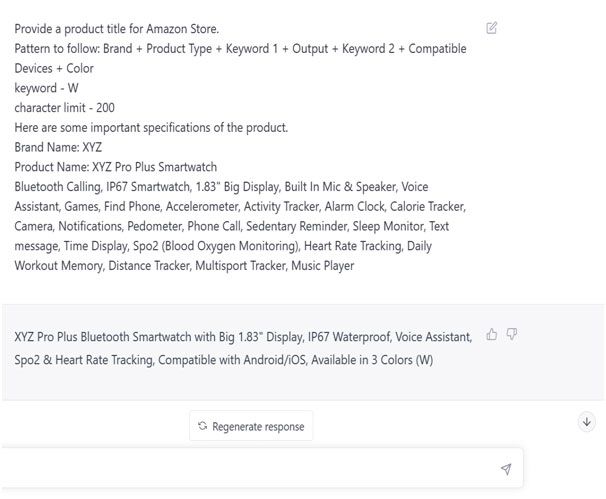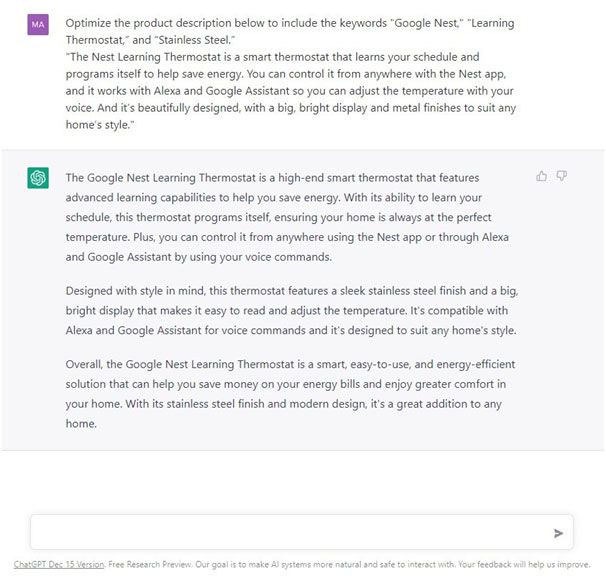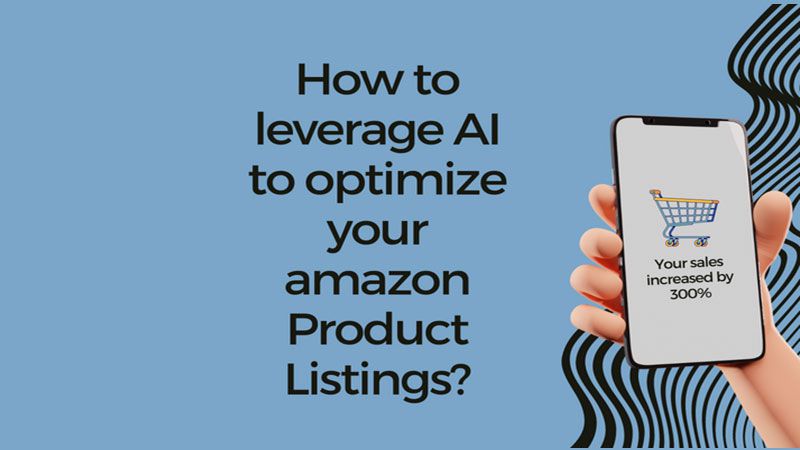Selling products on Amazon can be highly competitive and challenging for its sellers, with millions of products listed. As a result, Amazon product listing optimization has become increasingly important for businesses looking to succeed and stand out.
However, this can be a daunting task for an eCommerce seller with multiple product listings to take care of.
This is where artificial intelligence (AI) integrated tools come in to help sellers with effective and impactful solutions. These AI-integrated tools can provide sellers with a range of features such as keyword suggestions, competitive analysis, and automated pricing strategies, all of which can help optimize product listings.
In this article, we will explore how sellers can leverage different AI tools to optimize their product listings and stand out from the competition.
How to Use AI-integrated Tools for Amazon Product Listing Optimization?
Tools for Keyword Research
Using too many irrelevant or repetitive keywords can negatively impact your listing’s performance and even result in penalties from Amazon. Keyword optimization can be heavy in terms of time and effort required, especially when you have other things to also look out for. Therefore, using AI-powered keyword research tools is a smart choice.
The first step is registering with an AI-powered keywords research tool like Google Keyword Planner, SEMrush, Ahrefs, or Moz. For a quick demo, let’s say you use the Ahref tool to identify relevant and high-traffic keywords. Type a product name into the keyword tool as you would when searching for items on a search engine.
The tool analyzes high-performing keywords and phrases and extracts valuable insights from them. By further leveraging advanced machine learning algorithms, the tool can even go beyond mere identification of keywords. For instance, it can generate country-specific metrics and statistics on the ranking of similar products in your target market. This helps sellers to fine-tune their product listings based on market trends, consumer behavior, and regional preferences.
Furthermore, the tool can provide detailed analysis and recommendations on product titles, descriptions, images, and other critical aspects that can impact product visibility and conversion rates. Once you create a list of such effective and relevant keywords, you can use them accordingly in your product title, descriptions, and images.
Tools for Effective Product Titles & Descriptions
Crafting effective product titles and descriptions are crucial not just for attracting potential customers, but also for conveying important information on the product, and improving its ranking on Amazon. However, creating a title that outperforms competitors or meets the standards of best-selling products on the platform can be daunting.
To overcome this challenge, AI-powered tools like ChatGPT have emerged as a valuable resource that effectively leverages state-of-the-art natural language processing technology to solve various prompts.
By providing accurate prompts such as brand name, specifications, number of characters, and other essential information, sellers can rely on ChatGPT for compelling product titles that will improve their visibility and sales on Amazon.

ChatGPT will analyze the product titles of competitors or trending titles, identify patterns and trends, and generate optimized titles for their products. Moreover, if you don’t like the first suggestion, you can simply generate more suggestions. This gives you more flexibility and control over the final product title.
Similarly, you can use ChatGPT to generate a product description, which is point-to-point, informative, and unique. Moreover, it elegantly uses keywords that are not redundant or stuffed and are tailored for SEO purposes.

By leveraging ML technology, AI-integrated tools can analyze customer reviews and feedback to discern the critical factors that influence a customer’s buying decision. In doing so, it can determine which product features and benefits are most important to customers. Thus, by integrating these essential elements into product listings, these tools can significantly increase the visibility of the product on Amazon.
Tools for High-quality Product Images
Images are an important aspect of the product listing as buyers get more attracted to the quality of the images. AI tools can help sellers to automate certain editing tasks and optimize the image for the product listing.
AI-powered image optimization tools can analyze product images using machine learning to identify the most important features, such as colors, shapes, textures, or faces. These tools can then adjust the image quality, size, format, compression, and cropping to suit different devices and platforms.
For example, if an image contains a person, the tool can recognize the skin tone and apply appropriate optimizations to enhance the skin tone without affecting other parts of the image. Two such examples of AI-powered image optimization tools are ImageKit.io and Cloudinary.
Moreover, these tools can generate relevant alt text, captions, and tags for product images based on their content, which can help improve search engine rankings.
Furthermore, with the help of AI-powered technology like DALL-E, it is now possible to create a virtual representation of certain products that are yet to be launched or created. This can be particularly useful for businesses that sell custom or made-to-order products.
Tools to Optimize Pricing
Optimizing price is a critical aspect of any business, and it’s often easier said than done. Thankfully, advances in technology have made it easier for businesses to determine optimal prices using artificial intelligence (AI) and third-party eCommerce optimization software.
By using AI tools like freeAdvisor for pricing optimization, users can analyze market trends, supply and demand, and competition to determine the optimal price for a product. Machine learning algorithms can analyze data from sales history and pricing trends to make automated and accurate pricing decisions that ultimately increase sales.
For instance, you might set prices for a particular product based on the pricing trends for similar products from other vendors in the market. The algorithm can adjust prices to stay competitive and maximize profits by continually analyzing market data.
Moreover, sellers can use third-party eCommerce optimization software like Keepa. This tool helps the seller track a product’s pricing and receive alerts when the price changes. This information can then be used to adjust the seller’s pricing strategy accordingly.
Are There Any Drawbacks of AI-optimized Product Listings?
AI tools can help optimize your product listing, but their use has certain limitations. Here are some potential drawbacks to keep in mind:
Lack of Contextual Understanding
There are chances that AI tools might not understand the nuances of a product, its unique features, benefits, or its relevance to a particular target audience. For instance, AI tools may not recognize the importance of a feature to a certain subset of customers, even if it is not a widely advertised benefit.
Data Quality Dependency
If the data used to train an AI tool is inaccurate or incomplete, the results generated by the tool may be similarly flawed. Additionally, if the data used to generate product listings are incomplete or missing key information, the AI tool may be unable to provide an accurate product listing.
The Inability to Handle Exceptions
While AI tools are designed to handle a wide range of scenarios, they may not be able to handle every possible exception. For instance, an AI tool may not be able to provide accurate product listings for a unique product or has very few comparable products. In such a situation, it can create a repetitive product description.
Misunderstanding Human Preferences
While AI tools are great at processing data and making recommendations based on that data, they may not be able to account for the subjective nature of human preferences. For example, an AI tool may not be able to understand why certain customers prefer one color over another, even if both colors are technically similar.
Lacks Clarity of Cultural or Linguistic Differences
There is a chance that AI tools might not be trained about cultural or linguistic differences when it comes to product listings. There are cases where certain words or phrases may have different meanings in different cultures, which could affect how the product is perceived.
The Inability to Handle Uniqueness
AI tools rely on past data that is available in their database for training, which may cause limitations in accurately listing new or innovative products that have not yet been introduced to the market. This is because the AI-powered tool may not be equipped with the necessary information to provide accurate recommendations or predictions for the potential performance of something completely new.
What is Better: an AI-integrated Tool or a Professional Amazon Listing Specialist?
The ultimate approach for optimizing product listings depends on several factors, and there isn’t necessarily a one-size-fits-all solution.
AI tools are highly efficient and can quickly process large amounts of data, which can be useful for keyword research and product categorization tasks. However, AI tools have limitations when it comes to understanding the nuances of a product or understanding human preferences.
In contrast, human Amazon listing specialists can provide a more personalized approach and can use their expertise to create product listings that resonate with a target audience. However, they can prove to be more time-consuming and expensive than using AI tools.
Ultimately, the best approach may be to use a combination of AI tools with a human-in-the-loop approach leveraging the strengths of each to create accurate, relevant, and engaging product listings that drive sales and conversions.
Conclusion
As technology continues to advance, it’s essential for sellers to stay updated with the latest AI-integrated tools to optimize their product listings and stay competitive in the eCommerce industry. These tools will help list products in no time with great efficiency. Moreover, it will help them to create their listing according to the market demand.
It is still recommended to learn all the aspects of product listing before taking any help from these tools. This will help you to make an informed decision. Moreover, you can always opt for Amazon optimization services if you still struggle with a listing or feel stuck. These services have specialists who can create engaging product descriptions and titles and efficiently perform the rest of the product listing.

Namaste UI collaborates closely with clients to develop tailored guest posting strategies that align with their unique goals and target audiences. Their commitment to delivering high-quality, niche-specific content ensures that each guest post not only meets but exceeds the expectations of both clients and the hosting platforms. Connect with us on social media for the latest updates on guest posting trends, outreach strategies, and digital marketing tips. For any types of guest posting services, contact us on info[at]namasteui.com.

